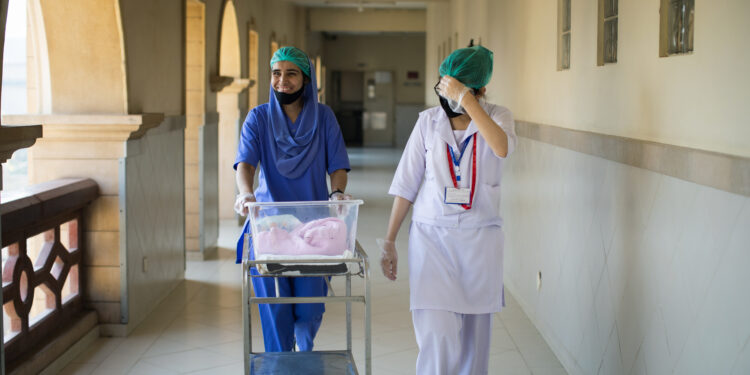Gender equality and pay equity for midwifery

Background
Gender inequality is not only a pressing moral and social issue but also a critical economic challenge. If women—who account for half the world’s working-age population— cannot achieve their full human and economic potential, family wellbeing will continue to suffer on a global scale. A common feature of women’s work is that it is invisible, undervalued, stereotyped, subject to prejudice and assigned a lower value than men’s work. (1) Midwifery is a predominantly female profession providing care to women and as such it is further undervalued.
A holistic framework to assess gender equality indicators for economic development include: (2)
- equality in work (equal pay for work of equal value, wage gap, leadership, unpaid care work)
- accessible essential services (maternity care, family planning, reproduction rights, education level)
- legal protection and political voice (representation and rights)
- physical security and autonomy (child marriage, violence)
Midwives are committed to providing the best quality and evidence-informed care to women, their newborns and their families but globally report that they are disrespected by senior medical staff, lack status and identity, and suffer gender inequality in their workplaces (3). Midwifery salaries are not comparable to other comparable professions and midwives often struggle to survive on the income they receive. This inequity ultimately impacts on or compromises the care that midwives can provide to women.
The World Health Organization recently reported that the critical role of women in health (70% health workforce) is often overlooked, so priority is not given to addressing gender/equity in the workforce. They have called for gender-transformative policies and measures to be put in place if global targets such as universal health coverage (UHC) are to be achieved (4). It has been estimated that an increase in the number of midwives providing midwifery care could substantially reduce maternal and neonatal mortality and stillbirths in low and middleincome countries (5).
Position
ICM believes that countries would benefit by focusing on the large economic opportunity that can be brought to families by improving gender equity and pay parity between male and female-dominant workforces such as midwifery.
ICM supports and strongly advocates for all efforts to reduce gender inequality and achieve pay equity for midwives and other women-dominant workforces.
Recommendations
Member associations are urged to work towards funding models that recognise pay parity principles and obliterate gender inequality in maternity services and the midwifery profession.
Member associations are urged to support funding models for midwifery and maternity services which recognise pay equity principles that promote and quantify equal pay for work of equal value. (6)
The International Labour Organization (ILO) workforce equity principles/programmes report pay equity can be achieved through a planned and structured process which involves the following steps: (7)
Identifying female-dominated jobs and male-dominated jobs to be compared;
- Choosing a job evaluation method;
- Developing tools for data collection and gathering data on the jobs;
- Analysing the results;
- Determining the value of jobs;
- Estimating wage gaps between jobs of equal value;
- Making pay adjustments to achieve pay equity.
Promoting the importance of midwives and midwifery work and recognising that midwives are critical to optimal health outcomes of any nation are required.
Achieving economic recognition requires supportive interventions to bridge the gender gap: e.g. financial incentives and support; technology and infrastructure; the creation of economic opportunity; capability building; advocacy and shaping attitudes; and laws, policies, and regulations.(6)
Achieving the necessary professional recognition requires: (8) (9) (10)
- Promoting support and valuing the caring nature of the professional relationship between the woman and her midwife.
- Supporting and valuing the continuity of midwifery model of care.
- Protecting professional autonomy and the ability to determine flexible employment arrangements, including self-employment.
- Promoting approaches that encourage co-operation and diminish competition between midwives.
- Providing structural support to enable sustainability of the workforce and the midwifery model of care.
- Developing a funding system that has flexible elements which enable services to respond to the individualised needs of pregnant women, families and local communities.
- Actively improving the educational framework, professional standard and quality assurance framework within which midwives operate.
Adopted at Virtual Congress, 2021
Due for next review 2023
(1) International Labour Organization. (2016). Integrated Strategy on Fundamental Principles and Rights at Work 2017 – 2023. ILO, Geneva. https://www.ilo.org/declaration/lang–en/index.htm
(2) Woetzel, J., et al. (2015). The power of parity: How advancing women’s equality can add $12 trillion to global growth. McKinsey Global Institute (MGI): https://www.mckinsey.com/
(3) World Health Organization, International Confederation of Midwives, and White Ribbon Alliance. (2016). Midwives’ voices, midwives’ realities. Findings from a global consultation on providing quality midwifery care. WHO, Geneva. https://apps.who.int/iris/handle/10665/250376
(4) World Health Organization. (2019). Delivered by women, led by men: a gender and equity analysis of the global health and social workforce. Human Resources for Health Observer Series;24. WHO, Geneva. https://apps.who.int/iris/handle/10665/311322
(5) Nove, A., et al. (2021). Potential impact of midwives in preventing and reducing maternal and neonatal mortality and stillbirths: a Lives Saved Tool modelling study. The Lancet Global Health. 9(1): p. e24- e32. https://www.thelancet.com/journals/langlo/article/PIIS2214-109X(20)30397-1/fulltext
(6) International Labour Organization. (1951). Convention No. 100. Convention Concerning Equal Remuneration for Men and Women Workers for Work of Equal Value. ILO, Geneva. https://www.ilo.org/wcmsp5/groups/public/@dgreports/@gender/documents/genericdocument/wcms_114185.pdf
(7) Chicha, M.T. (2009). Promoting equity: Gender-neutral job evaluation for equal pay. A step-by-step guide. ILO, Geneva. https://www.ilo.org/global/publications 7 Woetzel, J., et al. (2015). The power of parity: How advancing women’s equality can add $12 trillion to global growth. McKinsey Global Institute (MGI): https://www.mckinsey.com/
(8) Homer, C.S.E., et al. (2014). The projected effect of scaling up midwifery. The Lancet. 384(9948): p. 1146- 1157. https://www.thelancet.com/journals/lancet/article/PIIS0140-6736(14)60790-X/fulltext
(9) Renfrew, M.J., et al. (2019). Midwifery is a vital solution-What is holding back global progress? Birth. 46(3): p. 396- 399. https://pubmed.ncbi.nlm.nih.gov/31270851/
(10) Renfrew, M.J., et al. (2014). Midwifery and quality care: findings from a new evidence-informed framework for maternal and newborn care. The Lancet. 384(9948): p. 1129-1145. https://www.thelancet.com/journals/lancet/article/PIIS0140-6736(14)60789- 3/fulltext PS2021_EN_ Gender e
PS2020_003



